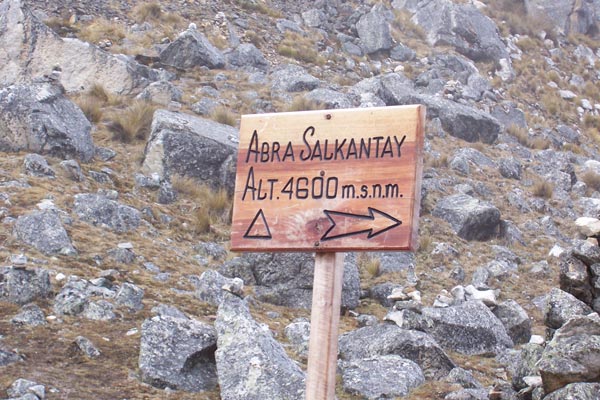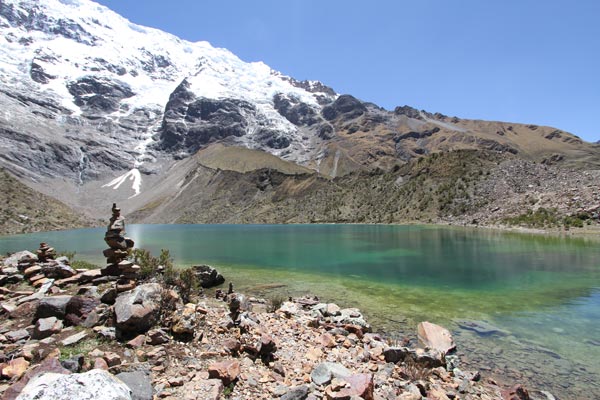THE SALKANTAY TREK
Frequently Asked Questions about the Salkantay Trek
Q1: How long does it take to get to Peru?Q2: When is the best time to go?
Q3: What enty documents do i need?
Q4: Is it safe to travel in Peru?
Q5: How do i get from the airport to the hotel on the escorted tours?
Q6: What type of transportation is used?
Q7: Will the altitude affect me?
Q8: What is the best thing to do in the event of altitude sickness?
Q9: Will I get high on coca leaves?
Q10: How do i reserve a space for the Salkantay Trek?
Q11: Do you require a deposit?
Q12: Is the Salkantay Trek Trail difficult?
Q13: What do I need to bring on the trek?
Q14: Should I request an extra pack horse?
Q15: What do we do for water along the Salkantay Trek?
Q16: What happens if I arrive at Machu Picchu and then decide to stay an extra night, can I change my train ticket?
Q17: What training do you provide for your staff on environmental practices?
Q18: What you do to minimise environmental impacts on the Salkantay Trek?
To Lima on a non-stop flight (recommended):
From Miami 5 1/2 hours
From New York 8 hours
From Los Angeles 8 1/2 hours
This is a difficult question to answer as Peru has a huge variety of weather conditions. We would say travelers can visit Peru any time of the year !
Dry season runs from May to November and this is typically the time that is most recommended. However, this is also the cooler time of year. Nighttime temperatures can drop to below freezing at the height of the dry season. June, July and August are the most popular months to visit so you will tend to encounter much larger crowds during these months.
In the wet season (December to April), you can expect showers three to four afternoons a week. For travelers that don't mind a little drizzle and muddy trails, this time of year offers smaller crowds and greener hillsides, with wildflowers and orchids often in bloom. The shoulder seasons, April to June or September to November can often provide the best of both worlds. They typically have fewer crowds and warmer temperatures than the height of the dry season, but still tend to have relatively little rain. For more information, check out our Peru Weather page.
U.S. citizens need a valid passport and an entry form-tourist card which is provided by your air carrier either at the ticket counter when checking in for your flight to Peru or once on-board. (NOTE: Other nationalities should check with the nearest Peruvian Consulate to determine correct entry requirements.)
Q4: Is it safe to travel in Peru? Definitely. We tend to hear the very worst news from Latin America. Helpful people and extraordinary culture. Most crime is opportunistic and not violent but, of course, it is possible to be in the wrong place at the wrong time. Care and common sense will nearly always prevail.
The Sendero Luminoso is no longer active.
All of our escorted tours include arrival transfer services, a Castle Travel representative will be waiting for you at the point of your arrival.
Q6: What type of transportation is used?Our escorted tours utilize a variety of transportation including private vans/ cars, comfortable tourist buses, flights, canoes, etc. We use a mix of private/ public transportation to provide travelers with the safest and most efficient transportation in each area. Occasionally, we may include non-typical transportation modes (rickshaw, bicycle taxi, "chicken bus", etc.) for short distances to give travelers a sense of local flavor.
Q7: Will the altitude affect me?When travelling throughout the Andes in Peru some people will suffer some effects of altitude sickness. If you plan to hike the Salkantay Trek we recommend arriving 2 or 3 days before the start to acclimatize and rest.
Q8: What is the best thing to do in the event of altitude sickness?Wherever possible "go down". But, if you are staying in Cusco, you may still feel the effects. The best advice is to sleep, take plenty of fluids and you could also try coca tea. The porters chew coca leaves wrapped around a black resin called llipta. When you are actually walking and active (especially on day two of the trail), this may help since it dilates vessels to increase the blood flow to the parts of the body that need it.
Q9: Will I get high on coca leaves?No - sorry! Although cocaine can be extracted from the leaves, it requires a long process involving acids and distilling. Your body simply does not have the capacity to extract much from the leaves.
Q10: How do i reserve a space for the Salkantay Trek?Please follow the link below for more details. Please read carefully before reserving
Click Here For Information on how to book the Salkantay Trek to Machu Picchu
If you prefer, call Inca Trail Reservations to verify availability of the trip you have chosen. Toll Free in the US: 1800.930.4319
Yes. We require a non-refundable booking deposit of US$250 for all treks and US$500 for all other tours.
Q12: Is the Salkantay Trek difficult?You know the answer to this one: it depends! You reach 4600m on the second day after climbing for the best part of the day. Especially if you are within your first five days at altitude, this may give you headaches and shortness of breath. Don't forget that even people who live in Cusco (at 3300m) still get short of breath.
Q13: What do I need to bring on the trek?Backpack, sleeping bag, mattress (we will provide you with this), rain jacket, strong footwear (walking boots are recommended as they provide support to the ankle which reduces the risk of injury especially when trekking in the wet season (December - March). However, it is important that your boots are comfortable and well worn-in and not brand new. Many people prefer to trek in tennis shoes but extra care should be taken. We do not recommend trekking in sandals. One complete change of clothing, sweater, jacket (something warm), water bottle and sterilizing tablets (Micropur are recommended and can be bought in local pharmacies in Cusco), flashlight and batteries, broad-brim or peaked cap, sunblock, insect repellent, toiletries and toilet paper, selection of small snacks, chocolate, dried fruit, biscuits etc, camera and plenty of film. You also have to bring your original passport with you on the trek.
Q14: Should I request an extra pack horse?It is better to request a pack horse before you go on the trail rather than realize halfway through that you’re not enjoying carrying your pack at this altitude and want some help. Remember that the tour price includes 8 kg per trekker to be carried by horses. If you plan to take more weight, please request a pack horse. Each pack horse will carry up to 30 kg of your stuff.
Q15: What do we do for water along the Salkantay Trek?At meal times we will give you teas, coffees etc to drink. You'll come across several mountain springs, fountains or small streams along the trail where you can fill up your water bottle. Take a bottle of at least 1½ liter capacity per person. Although the water looks clean, it is always safer to use sterilizing tablets or a water filter. With these tablets you have to wait between 30 and 40 minutes before drinking. Bottled mineral water can also be taken from Cusco or bought at Mollepata or Santa Teresa.
Q16: What happens if I arrive at Machu Picchu and then decide to stay an extra night, can I change my train ticket?It is still possible to make changes to your return train ticket if you decide to stay an extra night at Aguas Calientes. You will have to take your train ticket personally to the train station in Aguas Calientes and ask them to change the return date of your ticket. You will probably be asked to pay an extra administrative fee and changing the ticket will be subject to availability of spaces the following day. If you change your ticket for a cheaper service then you will not be refunded the difference!
Q17: What training do you provide for your staff on environmental practices? Our guide teams have been trained in first aid and rescue and are regularly updated through seminars and courses in their respective fields. All of our trekking staff receives regular briefings on how to best comply with the Salcantay Trek Trail and Machu Picchu Sanctuary Regulations as well as on environmental awareness.
Our Credo in Nature
We are great believers in leaving the areas that we visit in as untouched a condition as is possible. We encourage everyone who travels with us to respect the land, the people, and their fellow travelers. This type of focus leads to amazing experiences and insights that bring a sense of satisfaction, which is difficult to create any other way, so be thinking responsibility, consideration, and FUN!
Our Environmental Management Policy and Commitment considers running our operations in a responsible way, according to the following:
* Selective disposal of garbage (organic & inorganic)
* Garbage withdrawal of Natural Protected Areas
* We provide toilet tents with chemical toilet facilities. All garbage is disposed of outside the Natural Protected Areas
* Avoid fires – no smoking allowed inside the tents
* Use of bowls for washing purposes to avoid the soap from being thrown over to the floor or to natural water sources
* Avoid disturbing animals
* No animal hunting allowed
* Preservation of the flora, no orchid taking allowed
* Walking over the Inca ruins, walls or archaeological sites is absolutely forbidden




